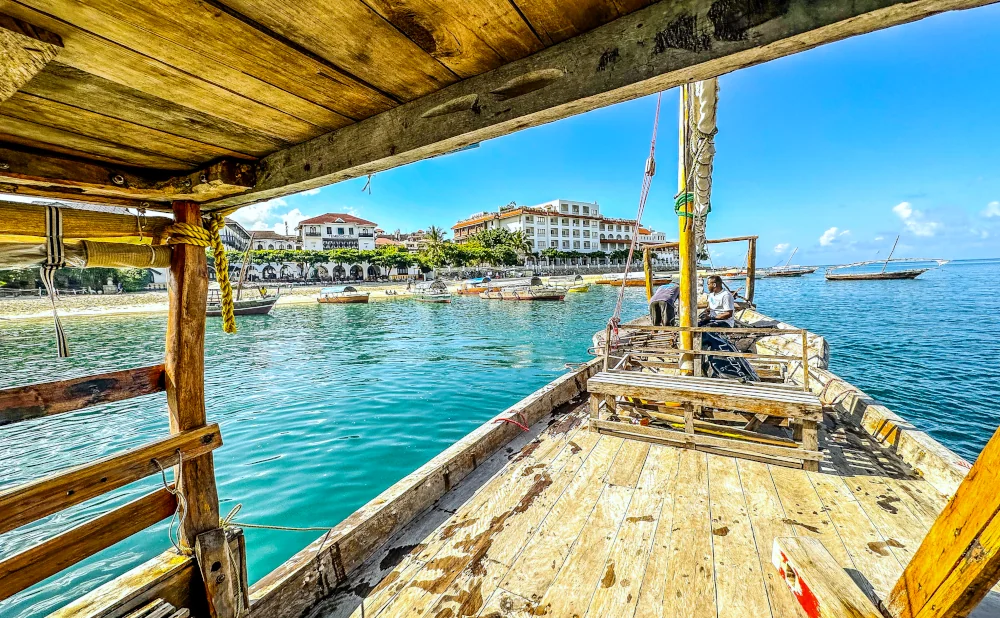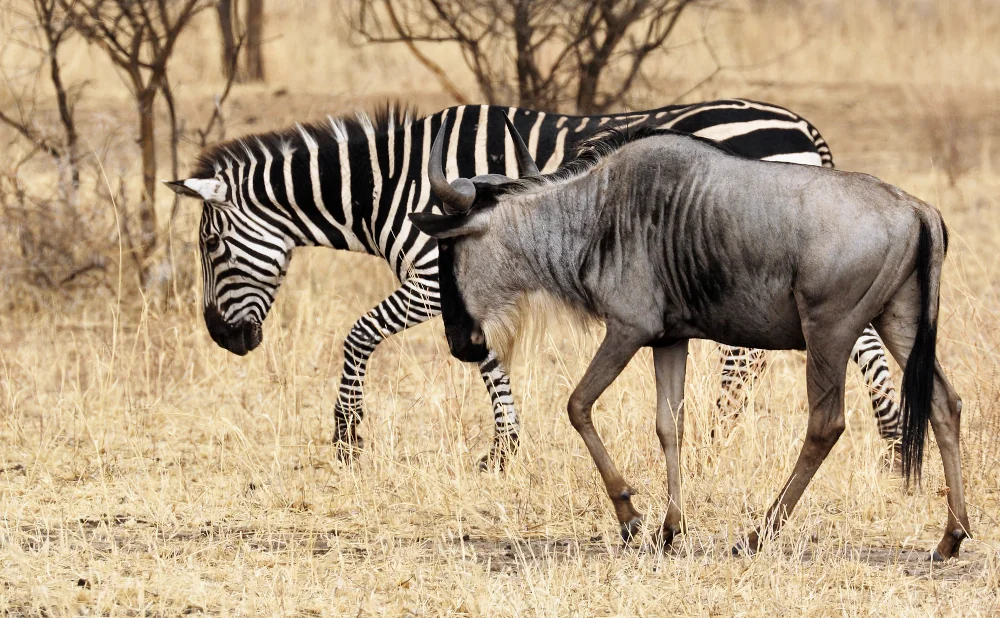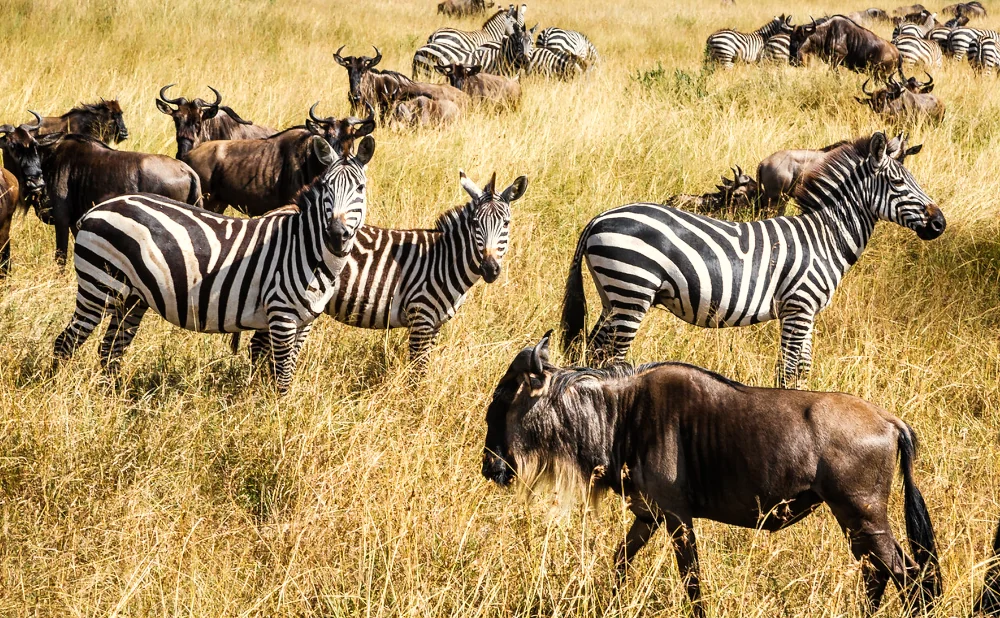Exploring the Wonders of Tanzania Safaris
Imagine a land where the wild roars of lions echo across vast plains. A place where herds of elephants roam freely under the shadow of towering baobab trees.
This is Tanzania, a country that is home to some of the most spectacular wildlife and natural landscapes in Africa.
In this guide, we will take you on a journey through the wonders of Tanzania safaris. We will explore the country's diverse national parks, each offering unique wildlife encounters and breathtaking scenery.
From the Great Migration in the Serengeti to the dense wildlife concentration in the Ngorongoro Crater, Tanzania offers an unparalleled safari experience.
Whether you are an adventure traveler, a wildlife enthusiast, or simply someone seeking a unique travel experience, this guide will provide valuable insights to help you plan your Tanzanian safari.
The Allure of Tanzania's Wildlife and Landscapes
Tanzania is a wildlife enthusiast's paradise. The country's diverse ecosystems, from savannahs to wetlands, host an array of wildlife species.
The Big Five - lion, leopard, rhinoceros, elephant, and Cape buffalo - are often the stars of the show. Yet, Tanzania's wildlife spectacle extends far beyond these iconic species.
Giraffes gracefully stride across the plains, while hippos wallow in muddy waterholes. Crocodiles lurk in rivers, and a myriad of bird species fill the skies with color and song.
The landscapes themselves are equally captivating. The endless plains of the Serengeti, the towering peaks of Kilimanjaro, and the sun-soaked beaches of Zanzibar all contribute to the country's allure.
Whether you're witnessing the Great Migration or spotting a leopard lounging in a tree, the wonders of Tanzania's wildlife and landscapes promise an unforgettable safari experience.
Tanzania's National Parks: A Treasure Trove of Biodiversity
Tanzania's national parks are a testament to the country's rich biodiversity. Each park offers a unique safari experience, with distinct landscapes and wildlife.
The Serengeti National Park, Ngorongoro Conservation Area, Tarangire National Park, and Selous Game Reserve are among the most renowned. These parks are home to a vast array of wildlife, including the Big Five and numerous bird species.
The Serengeti is famous for the Great Migration, a spectacle of millions of wildebeest and zebras moving in search of fresh grazing. Ngorongoro, with its volcanic crater, offers a unique natural enclosure for diverse wildlife.
Tarangire is known for its large elephant herds and iconic baobab trees. Selous, one of the world's largest faunal reserves, is a wild and untouched wilderness.
These parks, along with others in the country, offer unparalleled opportunities for wildlife viewing. They are less crowded than some other popular safari destinations, providing a more intimate experience.
Here are some highlights of Tanzania's national parks:
- Serengeti National Park: Great Migration, Big Five, diverse birdlife
- Ngorongoro Conservation Area: Big Five, birdlife, Olduvai Gorge
- Tarangire National Park: Large elephant herds, baobab trees, birdlife
- Selous Game Reserve: Wild dogs, elephants, hippos, crocodiles
Serengeti National Park: The Great Migration and Beyond
The Serengeti National Park is a wildlife haven. It's most famous for the Great Migration, an annual event where millions of wildebeest and zebras traverse the plains in search of fresh grazing.
This dynamic event is a spectacle to behold. The timing can vary each year due to weather patterns, but it's always a highlight of any safari.
The Serengeti is also home to the Big Five and a diverse array of other wildlife. Its vast plains and scattered kopjes provide a variety of habitats for these animals.
Ngorongoro Conservation Area: A Natural Wonder
The Ngorongoro Conservation Area is unique. Its main feature, the Ngorongoro Crater, is a natural enclosure for wildlife.
This volcanic crater is often referred to as 'Africa's Eden'. It hosts a dense concentration of wildlife, including the Big Five.
The area is also an important paleoanthropological site. The Olduvai Gorge, located within the conservation area, has yielded numerous early human fossils.
Tarangire National Park: Giants and Baobabs
Tarangire National Park is known for its large elephant herds. These majestic creatures can often be seen roaming the park, especially during the dry season.
The park is also famous for its baobab trees. These towering giants dot the landscape, adding to the park's unique charm.
Birdwatchers will also enjoy Tarangire, with over 500 bird species recorded in the park.
Selous Game Reserve: Wild and Untouched
The Selous Game Reserve is a wild and untouched wilderness. It's one of the largest faunal reserves in the world and a UNESCO World Heritage site.
The reserve is home to a variety of wildlife, including elephants, wild dogs, and crocodiles. The Rufiji River, which flows through the reserve, is ideal for boat safaris.
Visitors to Selous can enjoy a more secluded safari experience, away from the crowds.
Planning Your Safari en Tanzania: Tips and Insights
Planning a safari in Tanzania can be an exciting process. There are many factors to consider, from choosing the right parks to visit, to deciding on the best time of year for wildlife viewing.
Safari tours range from budget-friendly to luxury options. This caters to different preferences and budgets. It's important to research and choose a reputable safari operator.
Game drives are the most popular way to explore the parks. However, walking safaris and hot-air balloon rides offer unique perspectives of the Tanzanian wilderness.
Understanding the behavior and movement patterns of wildlife can enhance the safari experience. Knowledgeable guides can greatly enhance the safari experience by sharing insights about the wildlife and environment.
Here are some key considerations when planning your safari:
- Choose the right parks based on your interests and the wildlife you want to see
- Decide on the best time of year for wildlife viewing
- Consider your budget and choose a safari tour that suits your needs
- Research and choose a reputable safari operator
- Consider different safari activities, such as game drives, walking safaris, and hot-air balloon rides
- Learn about the wildlife and their behavior to enhance your safari experience
Best Time to Visit for Optimal Wildlife Viewing
The best time to visit Tanzania for a safari is during the dry season. This is from late June to October.
During this time, animals congregate around water sources. This makes wildlife viewing easier. The vegetation is also less dense, improving visibility.
However, each season offers unique experiences. The green season brings lush landscapes and is the best time for birdwatching and seeing newborn animals.
Safari Accommodations: From Budget to Luxury
Accommodations on a Tanzanian safari can range from budget to luxury. There are tented camps, lodges, and luxury resorts available.
Some safari camps are seasonal. They move with the migration to offer the best wildlife viewing opportunities.
The cuisine on safari often includes local and international dishes. There's an emphasis on fresh, locally-sourced ingredients.
Health and Safety: Vaccinations and Precautions
Health and safety are important considerations when planning a safari in Tanzania. Visitors should be aware of the necessary vaccinations and health precautions.
Travel insurance is recommended for all visitors. It's also important to pack essentials like sun protection and appropriate clothing for varying temperatures.
Visitors should respect wildlife and maintain a safe distance at all times. The use of drones is typically prohibited in national parks to avoid disturbing wildlife.
Engaging with Tanzania's Rich Culture and People
Tanzania is not just about wildlife. It's also home to a rich cultural heritage. Over 120 ethnic groups coexist in this East African nation.
The Maasai, Hadzabe, and other tribes offer unique cultural experiences. Visitors can learn about their traditional ways of life, which are closely tied to the land and wildlife.
Cultural experiences may include visits to Maasai villages, markets, and local schools. These interactions provide a deeper understanding of Tanzania beyond its wildlife.
The Maasai: Guardians of the Land
The Maasai are one of the most well-known tribes in Tanzania. They are often referred to as the guardians of the land. Their traditional way of life revolves around their livestock and the natural environment.
The Maasai have a deep respect for wildlife. They live in harmony with nature, a concept that is central to their beliefs and traditions.
Visiting a Maasai village can be a highlight of a Tanzanian safari. It offers a glimpse into their vibrant culture, traditional dances, and colorful attire.
Beyond Wildlife: Cultural and Historical Sites
Tanzania is also home to important cultural and historical sites. The Olduvai Gorge, located in the Ngorongoro Conservation Area, is an important paleoanthropological site.
The Zanzibar Archipelago offers a rich history and unique cultural experiences. Its beautiful beaches can be combined with a safari for a beach and bush experience.
The annual Serengeti Cultural Festival showcases local music, dance, and crafts. It provides a cultural complement to wildlife safaris. This festival is a celebration of the diverse cultures that make up Tanzania.
Conservation Efforts and Eco-Tourism in Tanzania
Tanzania's national parks are not just tourist attractions. They are crucial for wildlife conservation. The Tanzanian government has set aside over 25% of its land for conservation purposes.
The fees collected from tourists contribute to the maintenance and protection of these parks. They also fund initiatives to combat poaching and protect endangered species.
Eco-tourism is encouraged in Tanzania. Many safari lodges and tours focus on sustainability and minimizing their impact on the environment.
Visitors can support conservation by choosing responsible safari operators and lodges. These operators adhere to strict environmental standards and contribute to local conservation efforts.
The Role of Tourism in Wildlife Conservation
Tourism plays a significant role in wildlife conservation in Tanzania. The revenue generated from tourism helps fund conservation efforts and protect endangered species.
The presence of tourists also deters poachers. Tourists act as additional eyes and ears on the ground, making it harder for poachers to operate undetected.
Moreover, tourism creates jobs for locals. This reduces their dependence on activities that can harm wildlife, such as poaching or deforestation.
How You Can Contribute to Conservation
As a visitor, there are several ways you can contribute to conservation in Tanzania. One way is by respecting the rules and regulations of the national parks.
Avoid disturbing wildlife and maintain a safe distance at all times. The use of drones is typically prohibited in national parks to avoid disturbing wildlife.
You can also support conservation by adopting an animal or donating to wildlife foundations. These contributions help fund research, conservation projects, and anti-poaching efforts.
Conclusion: The Unforgettable Experience of a Tanzanian Safari
A safari in Tanzania is more than just a vacation. It's an opportunity to immerse yourself in the wonders of nature, witness the circle of life in action, and contribute to the preservation of some of the world's most spectacular wildlife.
The memories you make here will last a lifetime. From the thundering herds of the Great Migration to the tranquil beauty of a sunset over the Serengeti, every moment is a testament to the majesty of the natural world.
So, pack your bags, bring your sense of adventure, and get ready to explore the wonders of Tanzania safaris. You're in for an unforgettable journey.











